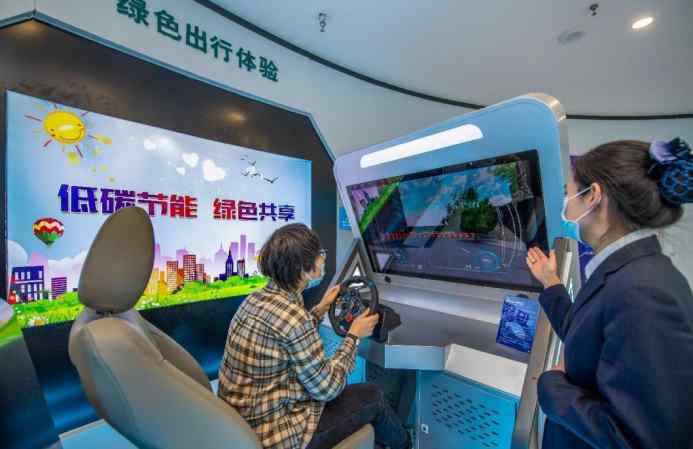China’s new urban infrastructure construction makes urban governance, people’s life easier
The urban lifeline operation monitoring system employed in Hefei, east China’s Anhui province, can display real-time monitoring data on urban infrastructure such as gas and water supply facilities and bridges on a screen.

A citizen tries driving a virtual new energy vehicle at a smart energy experience center in Yuncheng city, north China’s Shanxi province, Feb. 24, 2021. (People’s Daily Online/Xue Jun)
Trough diagram showing the spatial distribution of safety hazards to urban infrastructure with four colors that represent different levels of risks, i.e. red, orange, yellow and blue, the system makes locations with potential hazards clearly visible.
Since its implementation over four years ago, the system has cumulatively forecast and issued early warnings against more than 6,000 emergencies including gas pipeline network leakage, excessive biogas concentration, water distribution network leakage and road cave-in, helping reduce the incidence of the city’s underground pipe network accidents by 60% and improve hazard screening efficiency by 70%, according to Li Xuan, deputy director at the center for urban lifeline operation monitoring equipped with the system.
After years of rapid and large-scale construction, many Chinese cities have accumulated plenty of hazards to their complex subsystems of urban governance in such fields as administration, transportation, and communications. As a result, there is an urgent need of promoting new urban infrastructure construction.
According to an official with the Ministry of Housing and Urban-Rural Development (MOHURD), new urban infrastructure construction includes such key tasks as comprehensively advancing the building of City Information Modeling (CIM) basic platforms to lay the foundations of smart city construction; building intelligent municipal infrastructure and carrying out upgrading, transformation, and intelligent management of facilities concerning water supply, heating, gas, and other utilities of municipal infrastructure; driving the coordinated development of smart cities and intelligent connected vehicles (ICVs) for the construction of a smart transportation platform; pushing ahead with the construction of smart communities at a faster pace; promoting the coordinated development of intelligent construction and industrialization of construction; and stimulating the construction of urban operation, management, and service platforms.
In 2020, the MOHURD carried out the first batch of pilot projects for new urban infrastructure construction in 16 Chinese cities including Chongqing, Fuzhou and Jinan. Meanwhile, it arranged a series of specialized pilot projects for CIM basic platform construction as well as intelligent administration and construction.

Children watch a newly employed cleaning robot at Zhengzhou Zhilin Park, Zhengdong New District, Zhengzhou city, central China’s Henan province, Dec. 20, 2021. (People’s Daily Online/Zhang Tao)
Liang Feng, leader of network security and informatization experts’ group under the MOHURD, noted that through renewal and transformation of urban infrastructure oriented to digitalization, grid-based management and intelligentization, China is able to speed up the transformation of ways to manage urban construction, improve the overall level of urban construction and operational efficiency, and promote the modernization of urban governance system and capacity.
With the construction of smart communities, high-quality services such as elderly care, fitness, and delivery become more easily accessible to residents and can thus meet their diverse needs.
Unmanned buses and delivery vehicles, smart cameras that can accurately detect high-rise littering, smart trash cans that can automatically weigh and count garbage items, and smart greenways that allow residents to check their movement trajectories by scanning a QR code, among other facilities empowered by smart technologies, have made residents’ life more convenient.
New urban infrastructure construction projects are also helpful for driving industrial upgrading and cultivating new economic growth drivers.
Through the implementation of relevant projects, new urban infrastructure construction, which involves strong industrial chains, can promote the application of new technologies and the clustering of new industries, and advance the development of new business forms and improvement in new consumption, eventually unleashing the huge potential of urban development and driving effective investment.

Citizens watch a 5D immersive digital sand table at the Shanghai Urban Planning Exhibition Center, Feb. 23, 2022. (People’s Daily Online/Chen Yuyu)
At the end of last year, Chongqing issued a plan for the pilot projects of new urban infrastructure construction. According to the document, the municipality plans to invest over five billion yuan ($738 million) to advance 38 pilot projects, including developing ICVs and expanding the coverage of intelligent sensing devices to over 10 kilometers of road, as well as piloting more than 100 projects for the digital construction of engineering projects, and implementing projects integrating construction industrialization and informatization that cover an area of over 15 million square meters.
By 2025, Chongqing will incubate a batch of leading enterprises in new urban infrastructure construction, which will generate a capacity of over 100 billion products and services, said the document.
An MOHURD official said that the country will accelerate the construction of a three-tier CIM basic platform system at the national, provincial, and city levels; comprehensively promote smart municipal administration, smart community, and smart construction; coordinate the development of smart cities and ICVs; and speed up the implementation of new urban infrastructure construction projects by building demonstration bases.
Photos
 China’s central bank to issue commemorative coins on cultural theme of auspiciousness, including two heart-shaped coins
China’s central bank to issue commemorative coins on cultural theme of auspiciousness, including two heart-shaped coins Population of endangered black-headed gulls exceeds 10,000 mark in NE China’s coastal city of Panjin
Population of endangered black-headed gulls exceeds 10,000 mark in NE China’s coastal city of Panjin China's self-developed floating airship breaks record
China's self-developed floating airship breaks record Chinese germplasm bank conserves biodiversity in warm temperate zone
Chinese germplasm bank conserves biodiversity in warm temperate zone
Related Stories
- China speeds up future-oriented infrastructure development
- Prioritizing infrastructure creation set to stabilize economy
- China increases investment in road, waterway infrastructure in Q1
- Way of life -- Chinese company builds new roads, new lives in Sri Lanka
- China ups investment in road, waterway infrastructure
- China to boost new infrastructure projects amid economic recovery
- China to foster urban environmental infrastructure construction
- China's 20-bln-yuan policy loans support county-level infrastructure construction
- 'Small Three Gorges of Ganjiang' starts full operation
- Exploring China's "museum of world bridges" with FPV drones
Copyright © 2022 People's Daily Online. All Rights Reserved.






